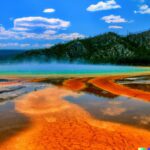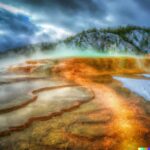Yellowstone National Park is home to some of the most iconic geysers in the world, including the famous Old Faithful and Steamboat Geyser. But beyond their awe-inspiring beauty, these geysers play a crucial role in monitoring volcanic activity in the park.
In this article, we will explore the importance of researching and monitoring geyser activity in Yellowstone, the potential hazards they pose, and how scientists use various methods such as ground deformation measurements, seismic monitoring, and gas emissions monitoring to track changes in these geothermal wonders.
Join us as we delve into the fascinating world of geysers and discover what scientists have learned from monitoring their activity in Yellowstone.
What Is Yellowstone National Park?
Yellowstone National Park, located primarily in the U.S. state of Wyoming, is renowned for its mesmerizing geothermal features, diverse ecosystem, and ongoing conservation efforts to preserve its status as one of the world’s most remarkable natural wonders.
Established as the first national park in the world in 1872, Yellowstone has captivated visitors with its erupting geysers, colorful hot springs, and bubbling mud pots. The park’s iconic Old Faithful geyser alone draws millions of tourists annually.
Beyond its thermal wonders, Yellowstone boasts a rich array of wildlife, including grizzly bears, wolves, elk, and bison. Conservation programs within the park aim to protect these species and their habitats, highlighting the interconnectedness of nature within this vital ecosystem.
What Are Geysers?
Geysers are hydrothermal features characterized by intermittent hot water eruptions, often exhibiting distinct thermal anomalies and eruption patterns that are indicative of underlying geothermal activity and the presence of hydrothermal vents.
These formations, which are commonly found in geologically active regions, showcase a unique behavior where water heated by magma beneath the Earth’s surface builds up in underground chambers. As pressure increases, the water is forced upwards through narrow fissures, resulting in powerful eruptions that can reach impressive heights. The periodicity of geyser eruptions is directly linked to the interactions between the heated water, steam, and the surrounding rock formations. This spectacular display of natural phenomena attracts numerous visitors, offering a glimpse into the fascinating geological processes at work.
Why Is It Important to Research and Monitor Geyser Activity in Yellowstone?
Researching and monitoring geyser activity in Yellowstone is crucial for understanding the dynamic interplay between geothermal features, seismic activity, and environmental factors within the park’s unique geological landscape.
Continuous observation allows scientists to not only track the behavior of geysers but also to study the underlying geothermal processes and their connections to seismic events. By analyzing these interactions, researchers can gain valuable insights into the geological forces at play and better predict potential hazards. Studying geyser activity provides a window into how changes in the geothermal system can impact the surrounding ecosystem, helping to safeguard the delicate balance of flora and fauna in Yellowstone National Park.”
What Are the Potential Hazards of Geysers?
Geysers, despite their natural beauty, can pose various potential hazards due to geological events, geologic hazards, and the potential environmental impact of their eruptions, necessitating careful monitoring and research to mitigate risks.
These unique geological features are primarily found in regions with high geothermal activity, making them prone to sudden and unpredictable eruptions that can result in scalding-hot water and steam blasts.
The release of toxic gases during geyser eruptions can have adverse effects on air quality and surrounding ecosystems.
The structural instability caused by geological events like earthquakes can lead to geysers collapsing, posing significant safety risks to nearby areas.
As such, implementing robust safety measures and conducting regular environmental monitoring are crucial steps in managing the inherent hazards associated with geysers.
How Do Geysers Indicate Changes in Yellowstone’s Volcanic Activity?
Geysers play a vital role in signaling changes in Yellowstone’s volcanic activity through their eruption patterns, temperature fluctuations, and other geothermal behaviors that provide valuable insights into the park’s dynamic geology.
These geologic formations expel hot water and steam from the earth’s interior, offering scientists a window into the underground processes.
By monitoring the frequency and intensity of geyser eruptions, researchers can track any deviations from normal behavior, which may indicate increased volcanic unrest.
Geysers’ temperature variations also offer crucial data, as shifts in heat levels can reveal potential shifts in the magma chamber beneath Yellowstone.
This data, combined with seismic measurements and gas emissions, aids in forecasting potential volcanic events and enhancing overall volcanic monitoring efforts within the park.
How Is Geyser Activity Monitored in Yellowstone?
Geyser activity in Yellowstone is carefully monitored using advanced techniques such as thermal imaging, seismic data analysis, and geospatial mapping to track and analyze changes in geothermal behavior and seismic patterns.
- Thermal imaging plays a crucial role in this monitoring process by capturing infrared radiation emitted by the Earth’s surface, allowing researchers to detect subtle temperature variations indicative of geyser activity.
- Seismic data collection involves measuring ground vibrations caused by the movement of fluids beneath the surface, helping to predict potential eruptions.
- Geospatial analysis integrates data from various monitoring equipment to create detailed maps illustrating the spatial patterns of geyser behavior and identifying areas of potential volcanic activity, enhancing our understanding of the complex geological processes at work within Yellowstone National Park.
Ground Deformation Measurements
Ground deformation measurements are essential for geotechnical assessments and geothermal research, providing valuable insights into the subsurface processes and structural dynamics associated with geothermal systems.
By monitoring the changes in the Earth’s surface, scientists can gauge the pressure and movement of magma beneath the surface, which is crucial for predicting volcanic eruptions and assessing potential hazards. Ground deformation measurements play a key role in understanding fault movements and the buildup of stress along fault lines, aiding in earthquake forecasting and mitigation strategies. These measurements also help in delineating groundwater flow patterns and identifying areas prone to subsidence or landslides, contributing to better land-use planning and disaster risk management.
Seismic Monitoring
Seismic monitoring plays a pivotal role in detecting and analyzing seismic activity within Yellowstone, aiding in geological research to better comprehend the subterranean processes and potential volcanic hazards associated with the region.
By constantly tracking and recording seismic events through advanced monitoring technologies, researchers can gain valuable insights into the movements of tectonic plates and potential magma chambers beneath the surface. This data is crucial not only for understanding the underlying geological dynamics but also for assessing the risks of potential volcanic eruptions. Geologists use the seismic data gathered to create detailed geologic surveys that help identify areas prone to seismic activity, contributing to the overall preparedness and response strategies for volcanic hazards.
Gas Emissions Monitoring
Gas emissions monitoring aids in tracking the release of geothermal fluids and gases, offering valuable insights into the underground processes associated with geothermal exploration and the behavior of hydrothermal systems.
By analyzing the composition and volume of gases emitted from geysers, researchers can infer the characteristics of geothermal reservoirs, such as temperature, pressure, and fluid content. These emissions serve as indicators of the activity level of underground heat sources and the movement of hydrothermal fluids. Monitoring gas emissions also helps in predicting potential volcanic eruptions and assessing the environmental impact of geothermal energy production.
Understanding the dynamics of gas emissions in geysers plays a crucial role in enhancing geothermal exploration strategies and sustainable utilization of geothermal resources.
Temperature and Pressure Monitoring
Temperature and pressure monitoring enables the assessment of thermal behavior and the establishment of a comprehensive geothermal monitoring network to track variations and anomalies in geyser activity.
By continually monitoring the temperature and pressure levels in geysers, researchers and scientists can gain valuable insights into the underlying thermal patterns and behaviors. This data is crucial for understanding the dynamics of geothermal systems and detecting any deviations that may indicate changes in activity levels.
Establishing effective monitoring programs not only helps in predicting potential eruptions but also in managing geothermal resources sustainably. By analyzing the data collected through these monitoring efforts, experts can better predict the behavior of geysers and ensure early detection of any irregularities that could pose risks.
What Are the Most Active Geysers in Yellowstone?
Yellowstone National Park is home to several incredibly active geysers, with notable examples including Old Faithful, Steamboat Geyser, Grand Geyser, and Castle Geyser, each offering a unique spectacle of geothermal power and natural beauty.
One of the most iconic geysers in Yellowstone, Old Faithful, earns its name due to its faithful and predictable eruptions, shooting scalding water up to 150 feet into the air at regular intervals, delighting visitors with its impressive displays.
On the other hand, Steamboat Geyser stands out for its sporadic but powerful eruptions, occasionally reaching heights of over 300 feet, making it the world’s tallest active geyser. These geysers not only enhance the park’s geothermal landscape but also provide valuable insights into the fascinating world of geothermal phenomena.
Old Faithful
Old Faithful is one of the most famous geysers in Yellowstone, known for its predictable geothermal activity and regularly timed eruptions that attract visitors from around the world.
Scientists have studied Old Faithful extensively to understand the underlying mechanisms that drive its eruptions. The geyser’s eruptions are influenced by a combination of factors, including the pressure of the water and steam building up underground. By monitoring the intervals between eruptions and the duration of each eruption, researchers have been able to develop models to predict the next eruption time with impressive accuracy. This predictive capability is a testament to the advancements in geyser research and the fascinating world of geothermal activity.
Steamboat Geyser
Steamboat Geyser holds the distinction of being the world’s tallest active geyser, with its sporadic but powerful eruptions providing valuable insights for geyser research and the study of thermal anomalies in geothermal systems.
As researchers delve deeper into understanding the behavior of Steamboat Geyser, they uncover intriguing patterns in its eruption frequency and thermal activity. The irregularity of its eruptions sets it apart from many other geysers, making each event a captivating event to witness. By closely monitoring the thermal patterns of Steamboat Geyser, scientists aim to decipher the underlying mechanisms that drive its impressive displays of geothermal energy. This valuable data aids in improving our overall comprehension of geothermal systems and contributes to the ongoing advancements in geothermal monitoring technology.
Grand Geyser
Grand Geyser is renowned for its majestic eruptions and intricate geologic features, making it a subject of interest for geologic surveys and the study of eruption patterns within Yellowstone’s geothermal landscape.
Its eruptions can reach heights of up to 150 feet, captivating spectators with its power and beauty. The geological structure of Grand Geyser includes a vent that releases steam and water in spectacular bursts, showcasing the dynamic nature of the geothermal activity in the area. Scientists utilize monitoring techniques like seismic data and temperature measurements to track the behavior of Grand Geyser, providing valuable insights into volcanic processes and eruption predictions. This natural wonder serves as a window into the inner workings of the Earth, offering a glimpse into the forces that shape the planet’s surface.
Castle Geyser
Castle Geyser captivates visitors with its castle-like structure and intricate hydrothermal systems, serving as a focal point for environmental monitoring efforts aimed at preserving the delicate balance of the geothermal ecosystem.
Surrounded by a vibrant landscape rich with diverse flora and fauna, the geyser stands out as a testament to the raw power of nature. Its unique structure, resembling a medieval castle, adds to the mystique that draws in onlookers from far and wide. The hydrothermal systems beneath the surface of Castle Geyser play a crucial role in shaping the surrounding environment, providing nutrients and energy for the ecosystem to thrive. Conservationists closely monitor these systems to ensure the sustainability of this natural wonder and protect the valuable resources it provides.
What Have Scientists Learned from Monitoring Geyser Activity in Yellowstone?
Through rigorous monitoring of geyser activity in Yellowstone, scientists have gained valuable insights and research findings that have enhanced their understanding of geothermal phenomena, seismic correlations, and geospatial data analysis in the region.
The continuous observation of geyser eruptions and the correlation with seismic events have led researchers to develop predictive models for volcanic activity. By analyzing the geospatial data collected from various monitoring stations, scientists can identify patterns and trends that help in forecasting potential geological hazards.
This interdisciplinary approach involves geologists, seismologists, and geospatial analysts working together to unravel the complexities of the Earth’s dynamic processes. These studies provide crucial information for mitigating risks associated with volcanic eruptions and understanding the underlying mechanisms driving geyser behavior.
Predicting Eruptions
Predicting geyser eruptions is a key area of focus for researchers, who utilize eruption patterns, monitoring stations, and advanced data analysis techniques to forecast the timing and intensity of volcanic events.
By studying historical eruption data and observing changes in underground pressure and temperature, researchers can identify potential indicators that precede a geyser eruption. Monitoring stations strategically placed around Yellowstone National Park continuously collect data on seismic activity, gas emissions, and ground deformation, providing crucial information for eruption forecasting. Advanced algorithms are used to analyze this data in real-time, helping scientists to create models that predict the behavior of geysers with increasing accuracy. This proactive approach not only aids in understanding volcanic processes but also enhances public safety by enabling timely evacuation and warnings.
Understanding Volcanic Processes
Monitoring geyser activity aids in understanding the intricate volcanic processes at work beneath Yellowstone, shedding light on geothermal dynamics, geologic events, and the underlying geological processes that shape the park’s unique landscape.
This monitoring provides valuable insights into the behavior of geothermal systems within the park, offering clues about potential geologic hazards and the conditions that lead to volcanic activity. By observing geyser eruptions and patterns, researchers can analyze how these thermal features interact with the surrounding rock formations, contributing to a deeper comprehension of the complex interplay between subsurface processes and surface manifestations. Such data not only enhances scientific understanding but also enables better hazard assessment and the development of strategies to mitigate risks associated with volcanic events.
Identifying Changes in Hydrothermal Systems
Monitoring geyser activity facilitates the identification of changes in Yellowstone’s hydrothermal systems, providing critical insights into the behavior of thermal features, the exploration of geothermal resources, and the sustainability of hydrothermal environments.
Understanding these alterations is crucial for researchers and conservationists alike, as it allows for early detection of potential disruptions to the delicate balance within these unique ecosystems.
By closely monitoring the geyser activity, experts can track fluctuations in temperature, pressure, and mineral composition, which play a vital role in preserving the natural state of Yellowstone’s geothermal areas.
This proactive approach not only aids in safeguarding the integrity of hydrothermal environments but also supports ongoing geothermal exploration efforts to harness clean energy sources more efficiently.
Last Updated on February 7, 2024 by Jon Waraas – Originally Posted: February 7, 2024

I’m Jon Waraas, and I’ve been navigating the online world since 2006. By day, I’m the proud owner of some eCommerce gems, and by night, I’m the voice behind the adventures on Waraas.Com.
My heart, however, belongs to the wild beauty of Yellowstone National Park. I’ve got a collection of websites dedicated to sharing the wonders of this natural masterpiece. Oh, and did I mention? I’m currently building my own cabin inside the ghost town of Gilmore, Idaho – a cabin with tales to tell!
When I’m not immersed in the digital realm, you’ll find me lacing up my boots for a good hike or setting up camp under the star-studded sky.




